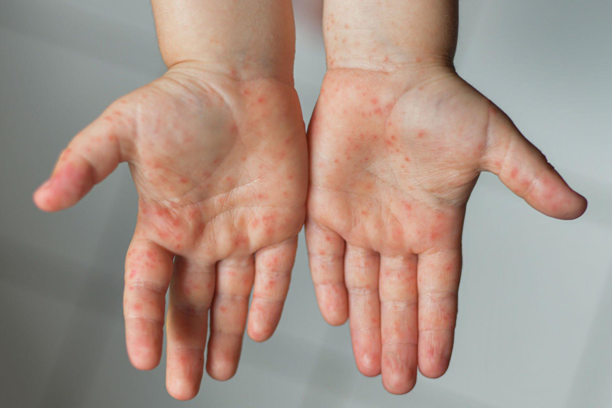Hand, foot, and mouth disease (HFMD) is a very contagious infection that everyone should be cautious about. The most prevalent offender, the coxsackievirus, is a member of the enterovirus genus.
Direct contact with unclean hands or surfaces that have been contaminated with faeces can cause these viruses to spread from one person to another. Additionally, contact with a person’s saliva, faeces, or respiratory secretions might spread it.
HFMD symptoms include a rash on the hands and feet, as well as blisters or sores in the mouth. The virus can affect people of any age, although it most usually affects kids under the age of five.
The majority of the time, it is a minor condition that resolves on its own in a few days.
Symptoms of hand, foot, and mouth disease
Between 3 and 6 days after contracting the virus, symptoms start to appear. The incubation period is this time frame. When symptoms do materialise, you or your child may:
- Fever
- Decreased appetite
- Sore throat
- Headache
- Irritability
- Malaise (feeling unwell)
- Painful red blisters in the mouth
- Drooling
- Your hands and feet develop a red rash.
A fever and sore throat are frequently the first indicators of HFMD. After the fever has started for one or two days, the recognisable rashes and blisters often start to develop.
Usually, the rash appears as flat, red patches. Darker skin tones can make the spots difficult to discern, so it is easier to inspect the bottoms of the feet and the palms of the hands, where the condition might be more obvious.
This is one of the few times when you will notice a rash on your palms and soles, making it easy to recognise, even though lesions can form on any area of your hands or feet.
Most children with HFMD also have unpleasant mouth sores. Check the sides of their tongue and neck in particular.
Causes of hand, foot, and mouth disease
HFMD is frequently brought on by a coxsackievirus strain, most frequently coxsackievirus A16. A pathogen belonging to the enterovirus family is the coxsackievirus. Occasionally, different enterovirus types can cause HFMD.
Viruses can be quickly transferred from one person to another. You or your child could contract HFMD by coming into contact with someone:
- Saliva
- Fluid from blisters
- Faeces
- As a result of coughing or sneezing, respiratory fluid is released into the air as tiny droplets.
Direct contact with unclean hands or a surface that has traces of the virus on it can also spread HFMD.
Risk for hand, foot, and mouth disease
The risk of HFMD is higher in young children. They are more at risk if they attend daycare or school since illnesses can spread quickly in these environments.
Children usually develop immunity to the disease after being exposed to the viruses that cause it. People beyond the age of 10 rarely develop the illness as a result.
The virus can still infect adults and older kids, especially if their immune systems are weakened.
Diagnosis of hand, foot, and mouth disease
HFMD is frequently found during a doctor’s physical examination. They will look for blisters and rashes around your mouth and body. The doctor will inquire about any other symptoms you or your kid may have.
The doctor may take a swab from the throat or a sample of the patient’s faeces for a virus test. They will be able to confirm the diagnosis in this way.
Treatment of hand, foot, and mouth disease
Without treatment, the infection will frequently go away in 7 to 10 days. However, your doctor may advise certain medications to help with symptom relief until the disease has run its course. These may consist of:
- Topical ointments with a prescription or available over-the-counter that can be used to treat blisters and rashes
- Headache relief with painkillers like ibuprofen or acetaminophen
- Medications in syrups or lozenges to relieve sore throat discomfort
Home remedies for hand, foot, and mouth disease
Some at-home therapies may also help to reduce the symptoms of HFMD. The home remedies listed below can help blisters become less uncomfortable.:
- Sucking on ice chips or popsicles
- Eating ice cream or sherbet
- Consuming cold beverages
- Reducing consumption of soda, citrus fruits
- Limiting spicy or salty foods
Gargling with warm salt water can help relieve throat sores as well as mouth sores. You can repeat this as many as necessary throughout the day.


One Comment
Pingback: Hand, Foot, and Mouth Disease: Symptoms and Causes – Sujata Birla Hospital